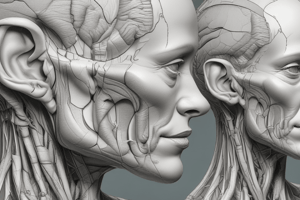Podcast
Questions and Answers
What is the primary role of the cochlea in the hearing process?
What is the primary role of the cochlea in the hearing process?
- To collect sound waves
- To equalize pressure in the ear
- To amplify sound waves
- To convert vibrations into electrical impulses (correct)
Which part of the ear is primarily involved in equalizing pressure?
Which part of the ear is primarily involved in equalizing pressure?
- Eustachian tube (correct)
- Cochlea
- Semi-circular canals
- Ossicles
What condition results from inflammation in the middle ear?
What condition results from inflammation in the middle ear?
- Tinnitus
- Otitis media (correct)
- Glue ear
- Otitis externa
Which structure collects sound waves and directs them to the auditory canal?
Which structure collects sound waves and directs them to the auditory canal?
What is the function of the semi-circular canals in the ear?
What is the function of the semi-circular canals in the ear?
What is the primary function of the cornea?
What is the primary function of the cornea?
Which part of the eye contains the light-sensitive cells responsible for vision?
Which part of the eye contains the light-sensitive cells responsible for vision?
What is myopia and how can it be corrected?
What is myopia and how can it be corrected?
What role does the iris play in vision?
What role does the iris play in vision?
What results from the absence of light-sensitive cells in the blind spot?
What results from the absence of light-sensitive cells in the blind spot?
Which of the following accurately describes the composition of the lens in the eye?
Which of the following accurately describes the composition of the lens in the eye?
How do rods and cones differ in their function?
How do rods and cones differ in their function?
What is the primary function of tears produced by the lachrymal glands?
What is the primary function of tears produced by the lachrymal glands?
Flashcards are hidden until you start studying
Study Notes
The Ear
- The outer ear consists of the pinna, auditory canal, and eardrum.
- The pinna collects sound waves and directs them towards the auditory canal.
- The eardrum vibrates when sound waves hit it, but these movements are small and need amplification.
- The middle ear contains the ossicles (hammer, anvil, and stirrup), which are the smallest bones in the body and amplify sound.
- The Eustachian tube connects the middle ear to the throat and equalizes pressure between the ear and the outer environment.
- The inner ear contains the cochlea and semicircular canals.
- The cochlea converts vibrations from the ossicles into electrical impulses.
- The stirrup vibrates against the oval window, sending pressure waves through the endolymph fluid in the cochlea.
- These waves cause tiny hairs in the cochlea to vibrate, generating nerve impulses that travel to the brain through the auditory nerve.
- The semicircular canals are responsible for balance, providing information about movement and orientation in three dimensions.
Hearing Defects
- Otitis media is an inflammation of the middle ear, leading to pain. It is caused by a bacterial infection and treated with antibiotics.
- Glue ear is a buildup of fluid in the middle ear, resulting in hearing loss. A grommet (tiny tube) is inserted into the eardrum to drain the fluid.
The Eye
- The conjunctiva is a thin, transparent layer at the front of the eye, continuous with the skin. It prevents foreign objects from getting behind the eye and is very sensitive.
- The sclera is the white part of the eye. It is a thick, rigid, fluid-filled ball made of collagen, giving the eye its shape.
- The cornea is a transparent section of the sclera at the front of the eye, acting as the main focusing component.
- The iris is the coloured part of the eye, with its colour determined by genes. The iris controls the size of the pupil, regulating the amount of light entering the eye.
- The pupil is the opening in the iris that appears black because no light is reflected from it. Muscles in the iris contract to dilate or constrict the pupil.
- The lens is biconvex, transparent, and elastic. It changes shape to focus light onto the retina.
- The retina is a layer of light-sensitive cells on the inner surface of the eye, converting light into nerve impulses sent to the brain via the optic nerve.
- The retina contains two types of light-sensitive cells: rods and cones.
- Rods are responsible for black and white vision and work best in dim light.
- Cones contain pigments that detect blue, red, and green light, working primarily in bright light.
- The blind spot is an area on the retina with no light-sensitive cells, where all axons from light-sensitive cells exit the eye.
- The choroid contains blood vessels providing oxygen and nutrients to the retina.
- Tear glands produce tears to cleanse the eyes.
Sight Defects
- Short-sightedness (myopia): Difficulty seeing distant objects clearly. Caused by an eyeball that is too long, resulting in the image focusing in front of the retina. Corrected by using concave lenses, which bulge inwards.
- Long-sightedness (hypermetropia): Difficulty seeing close objects clearly. Caused by an eyeball that is too short, resulting in the image focusing behind the retina. Corrected by using convex lenses, which bulge outwards.
Studying That Suits You
Use AI to generate personalized quizzes and flashcards to suit your learning preferences.




